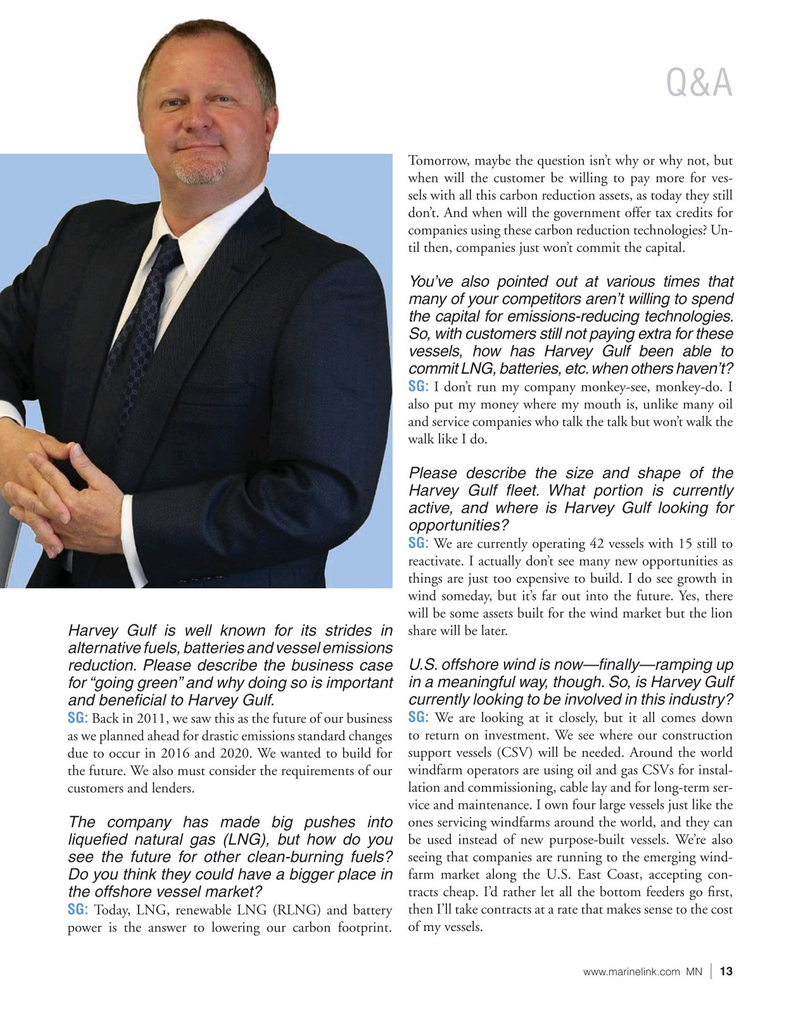
Page 13: of Marine News Magazine (April 2022)
Offshore Energy
Read this page in Pdf, Flash or Html5 edition of April 2022 Marine News Magazine
Q&A
Tomorrow, maybe the question isn’t why or why not, but when will the customer be willing to pay more for ves- sels with all this carbon reduction assets, as today they still don’t. And when will the government offer tax credits for companies using these carbon reduction technologies? Un- til then, companies just won’t commit the capital.
You’ve also pointed out at various times that many of your competitors aren’t willing to spend the capital for emissions-reducing technologies.
So, with customers still not paying extra for these vessels, how has Harvey Gulf been able to commit LNG, batteries, etc. when others haven’t?
SG: I don’t run my company monkey-see, monkey-do. I also put my money where my mouth is, unlike many oil and service companies who talk the talk but won’t walk the walk like I do.
Please describe the size and shape of the
Harvey Gulf ? eet. What portion is currently active, and where is Harvey Gulf looking for opportunities?
SG: We are currently operating 42 vessels with 15 still to reactivate. I actually don’t see many new opportunities as things are just too expensive to build. I do see growth in wind someday, but it’s far out into the future. Yes, there will be some assets built for the wind market but the lion share will be later.
Harvey Gulf is well known for its strides in alternative fuels, batteries and vessel emissions reduction. Please describe the business case U.S. offshore wind is now—? nally—ramping up for “going green” and why doing so is important in a meaningful way, though. So, is Harvey Gulf and bene? cial to Harvey Gulf. currently looking to be involved in this industry?
SG: Back in 2011, we saw this as the future of our business SG: We are looking at it closely, but it all comes down as we planned ahead for drastic emissions standard changes to return on investment. We see where our construction due to occur in 2016 and 2020. We wanted to build for support vessels (CSV) will be needed. Around the world the future. We also must consider the requirements of our windfarm operators are using oil and gas CSVs for instal- customers and lenders. lation and commissioning, cable lay and for long-term ser- vice and maintenance. I own four large vessels just like the ones servicing windfarms around the world, and they can
The company has made big pushes into be used instead of new purpose-built vessels. We’re also lique? ed natural gas (LNG), but how do you seeing that companies are running to the emerging wind- see the future for other clean-burning fuels? farm market along the U.S. East Coast, accepting con-
Do you think they could have a bigger place in tracts cheap. I’d rather let all the bottom feeders go ? rst, the offshore vessel market?
SG: Today, LNG, renewable LNG (RLNG) and battery then I’ll take contracts at a rate that makes sense to the cost power is the answer to lowering our carbon footprint. of my vessels.
www.marinelink.com MN 13|

 12
12

 14
14
